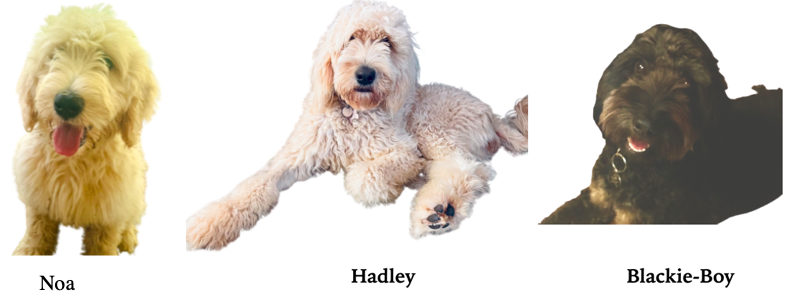Therapy Dogs in training
Meet Hadley and Noa our Golden Retriever x Poodles (Goodles) who both work with psychologist, Rachel Gleave and Blackie-boy our medium sized Labrador Retriever x Poodle (Australian Labradoodle) who works with psychologist, Samantha Carruthers.
Hadley is 3 years old and is approximately 25kgs. Blackie-Boy is 8 years old and is approximately 13kgs. Noa is Hadley's puppy, she is 1 year old and approximately 30kgs. All dogs have been completing their training to work as a therapy dog at the practice with their respective psychologist handlers. If you would like a therapy dog to be part of your sessions with Rachel or Samantha, you will need to read and sign the consent form for this service. There is no increase in charge for this service. Alternatively, you can opt to not have this service part of your sessions, as animal assisted interventions do not suit all clients’ preferences, needs and health.
ANIMAL ASSISTED THERAPY (AAT)
What is Animal Assisted Therapy?
Animal Assisted Therapy incorporates the use of animals, within a therapy session, to achieve a specific goal. Over the years, a building body of research has investigated the positive impact that the human-animal bond can have on both adults and children. As animals are non-judgemental and provide an unconditional love, they assist in increasing the engagement and rapport between therapist and client. Research has also shown that having animals incorporated within the therapeutic process can assist to reduce anxiety, increase relaxation and increase communication within sessions (Fine et al., 2015). All services are provided in accordance with the Animal Assisted Intervention International Standards of Practice and the Australian Psychology Services Code of Ethics.
Therapy Dog Training
The early training for therapy dogs focus on socialisation into the therapy room and to clients, as well as learning basic commands and impulse control. The dogs then begin their formal training with professional dog trainers, attending obedience classes and temperament assessments. Hadley has completed her Level 3 obedience training and Blackie-Boy is at Level 2 obedience training.
It will not be helpful for clients to overly excite or scare our therapy dogs or to encourage them to jump up or bark.
Clinical Benefits of Animal Assisted Therapy
There are many benefits associated with working with therapy animals in training and with AAT. Some benefits that have been found include:
- Animals provide a sense of safety, security and emotional support in the therapy room that can
help further improve motivation and engagement in psychotherapy (Fine et al., 2015), perhaps
resulting in a shorter recovery process (and lower costs to you). - Research has demonstrated that petting an animal can help lower blood pressure, heart rate,
and increase oxytocin (the bonding/calming chemical in the brain). Specifically, a study of the human brain revealed it has neurones that respond solely to animals. The nerve cells sit in the amygdala, a brain centre loaded with oxytocin neurones and critical to emotional evaluation and the stress response (Knobloch et al., 2012; Mormann et al., 2011). Oxytocin in particular, interacts with neurotransmitters such as dopamine, serotonin, noradrenalin, GABA, ACTH, and the opioids to calm our sympathetic nervous system (flight/flight/freeze defensive reflexes). Oxytocin has been shown to reduce stress response in people with a history of early trauma (Meyer-Lindenberg et al., 2012). It produces a unique effect of decreasing background anxiety without affecting learning or memory of a traumatic or stressful event (Missig et al. 2010).This is particularly beneficial in trauma processing, repairing attachment wounds, and working though interpersonal mistrust.
- Animals can help the client learn frustration tolerance, anger management techniques and social rules/boundaries; this is particularly beneficial for children and those on the Autism Spectrum (Fine et al., 2015).
- Animals in therapy ask for clients to develop empathy, nurturance, and responsibility, and model other skills like forgiveness and patience (Fine et al., 2015).
- Through the use of positive reinforcement-based dog training, clients can learn the importance of rewarding good behaviours in compassionate ways in themselves, their partners, and/or in their children (Fine et al., 2015).
Potential Risks of Animal Assisted Therapy
Even though there are many benefits to working with animals, there are risks involved in utilising this method of psychotherapy. For example:
- INJURY: dogs may nibble, accidentally scratch, lick, jump and/or lean up against you that
might cause injury. These actions are not aggression but rather dog’s way of interacting.
Specially, puppies might still be teething and learning to develop impulse control. - ALLERGIES: If you are allergic to dogs you may suffer from an allergic reaction. Hadley and
Blackie-Boy are crossed with poodle so they both have a hypoallergenic fleece coat. This means that they will not shed much dog hair. Our clinic dogs will be regularly groomed to help reduce shedding further. Although our dogs are less likely to cause an allergic reaction we cannot guarantee that she is allergy safe. If you are allergic to dogs, you can request to have your therapy sessions in an office that Hadley and Blackie-boy are restricted to enter. - ZOONOTIC DISEASE involves the sharing of disease between humans and animals. Every effort will be made to ensure against zoonotic disease transmission. Noa, Hadley and Blackie-Boy will remain current on all standard vaccinations and every effort will be made so that they are not exposed to other ill animals or humans. You may request to review a list of Noa, Hadley or Blackie-Boy’s vaccinations. Cairns Trauma & Clinical Psychology will supply antibacterial wipes, soap and hand sanitiser that you must use before and after interacting with the dogs. You should consult your doctor and inform our clinic of any health issues (i.e., autoimmune disease, compromised immune system, respiratory problems) prior to treatment with the dogs.
- FEAR OF DOGS: Therapy dogs can be a great resource for working through any dog phobias however, you should not conduct treatment with dogs if you are too uncomfortable as this can result in sensitisation (increasing of the fear/phobic response). Any fear, trepidation, and/or anxiety towards dogs must be disclosed prior to any animal-assisted therapy sessions. If you choose to work through your dog phobia with Noa, Hadley or Blackie-Boy, a treatment plan will be discussed and followed with your psychologist that will ensure that exposure interventions are timed appropriately for efficacious and safe treatment.
- Noa, Hadley and Blackie-Boy both deserves to be treated with respect and kindness. They should not be hit, yelled at, have their tail or any other parts pulled, be carried, or treated in any other way that is uncomfortable to them.
- Noa, Hadley and Blackie-Boy are allowed to determine if and when they participate with clients. While it may be planned to have them as part of your clinical treatment, consistent with animal welfare practices, they will never be forced to do so.
- Psychologists Rachel and Samantha are required to look out for the welfare and safety of both yourself and their dogs. If at any time Noa, Hadley or Blackie-Boy becomes distracting to your treatment or if the dogs becomes distressed, they will be removed and allowed to take a break. You may also ask at any time for Noa, Hadley or Blackie-Boy to be removed.
- There is a designated space at Cairns Trauma & Clinical Psychology for Noa, Hadley and Blackie- Boy only. This is their space where they can rest, sleep, and/or take a break. They are not to be disturbed whilst in this space (create in the therapy room or staff room).
- Due to the unpredictability of animals in unfamiliar situations, clients may not bring their own animal to be involved in the therapy session.
- Parents or guardians of children under the age of 10 years must remain on the premises
during their child’s session.
References
Fine, A. H. (Ed.). (2015). Handbook on animal-assisted therapy: Foundations and guidelines for animal- assisted interventions (4th ed.). Elsevier Academic Press.
Knobloch, H. S., Charlet, A., Hoffamn, L. C., Eliava, M., Khrulev, S., & Grinevich, V. (2012). Evoked axonal oxytocin release in central amygdala attenuates fear response. Neuron, 73(3), 553–566.
Meyer-Lindenberg, A., Domes, G., Kirsh, P., & Heinrichs, M. (2012). Oxytocin and vasopressin in the human brain: social neuropeptides for translational medicine. Nature Reviews Neuroscience, 12, 524–538.
Missig, G., Ayers, L. W., Schulkin, J., & Rosen, J. B. (2010). Oxytocin reduces background anxiety in fear- potentiated startle paradigm. Neuropsychopharmacology, 35(13), 2607–2616.
Mormann, F., Dubois, J., Kornblith, S., Milosavljevic, M., Cerf, M., Ison, M., et al. (2011). A category- specific response to animals in the right human amygdala. Nature Neuroscience, 14(10), 1247–1249.

